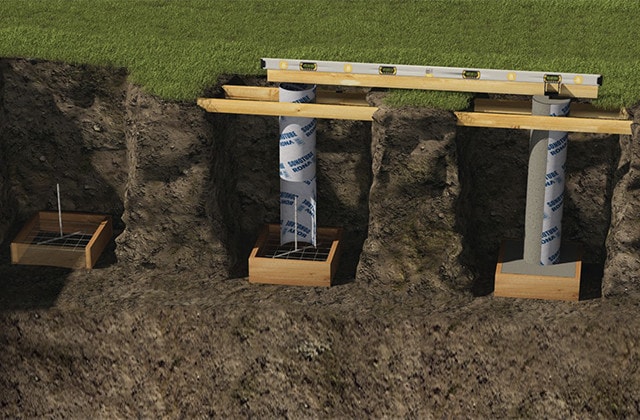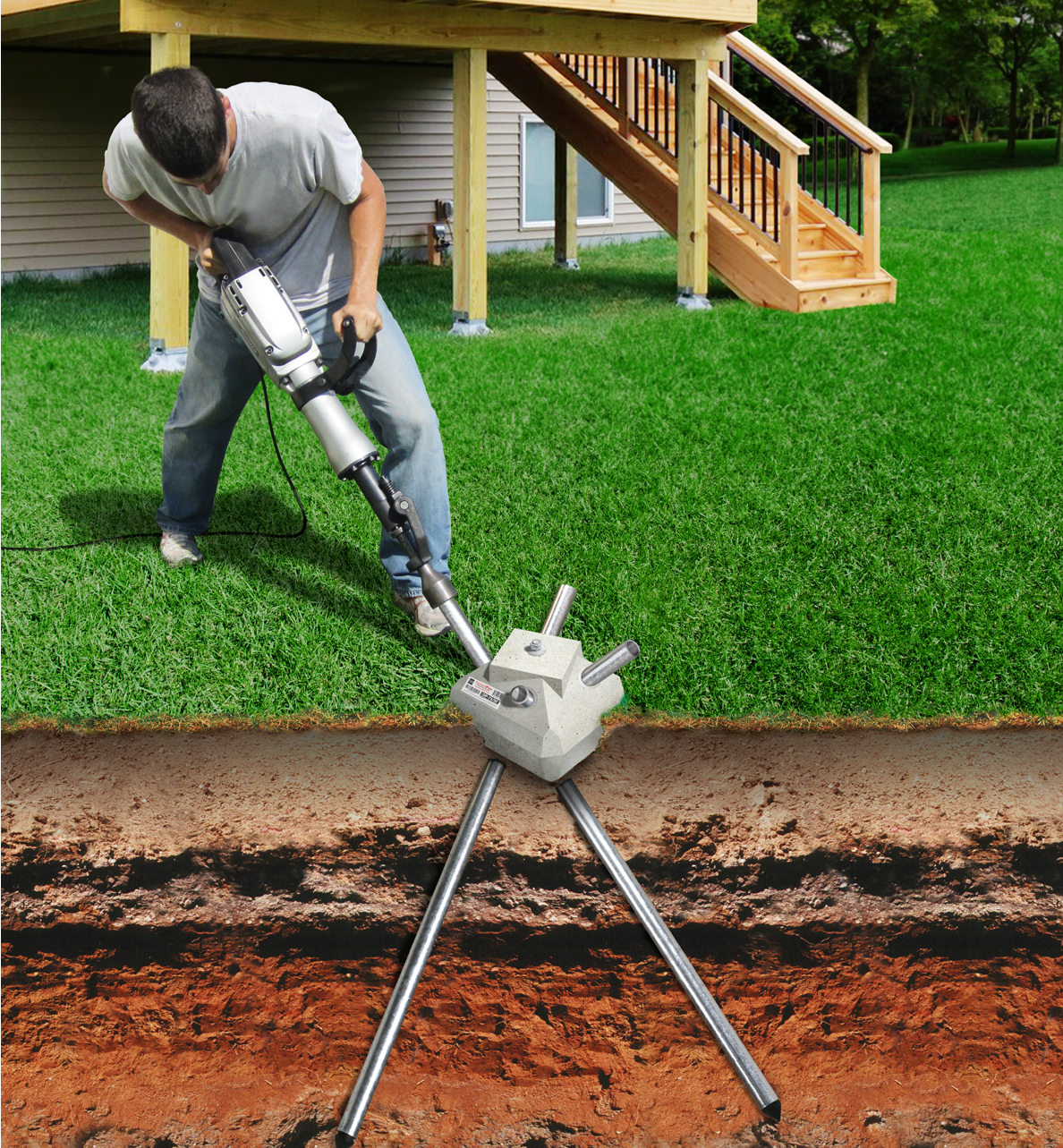Picking the Right Deck Footings for Security and Toughness
The durability and safety and security of your deck depend greatly on the kind of footings you choose, as they supply the important assistance and stability to withstand the test of time. In this discussion, we will discover the various kinds of deck grounds, consider the crucial factors to weigh when making a choice, and dig right into the pros and disadvantages of various options.
Sorts Of Deck Grounds
These footings are composed of a cylindrical opening loaded with concrete, which supplies a solid foundation for the deck posts. Concrete pier grounds are reasonably easy to install and provide superb security, making them a preferred selection for lots of deck jobs.
These footings are mounted by screwing them right into the ground, which develops a safe structure for the deck. They also allow for very easy adjustment and leveling of the deck if required.
Additionally, some contractors select precast concrete grounds. These grounds are made of resilient concrete and be available in numerous sizes and shapes to suit different deck layouts. Precast concrete footings are practical to install and provide a stable base for the deck framework.
Lastly, another alternative is the post-in-anchor footing system. This kind of ground includes driving a steel anchor into the ground and affixing it to the deck message. It provides versatility in regards to placing the deck articles and is appropriate for decks with light-weight structures.
When picking the right type of deck ground, it is important to consider aspects such as dirt conditions, deck lots, and neighborhood building regulations (Deck Footings). Consulting with a professional service provider or structural designer can help ensure the proper footing is selected for a risk-free and steady deck
Variables to Think About When Selecting Footings
When choosing the appropriate footings for a deck, it is important to meticulously think about different elements such as dirt problems, deck lots, and adherence to regional structure codes. These aspects play a considerable duty in ensuring the security and toughness of the deck structure.
The kind of soil on which the deck will certainly be constructed establishes the type of grounds called for. On the other hand, decks built on clay or extensive soils might need footings that can fit the dirt's tendency to broaden and contract.
One more important element is the deck lots. The weight of the deck, including the products used and any kind of potential real-time loads such as furniture or events, must be thought about when picking grounds. The footings should be developed to bear the weight of the deck and disperse it evenly to stop any architectural problems or failures.
Finally, adherence to regional building ordinance is critical. Building ordinance differ from region to area, and it is important to follow the certain demands set by the regional authorities. Deck Footings. These codes make sure that the deck is built safely and fulfills the required criteria for architectural stability and load-bearing capacity
Concrete Footings: Benefits And Drawbacks

Concrete grounds provide a number of advantages and negative aspects when used as the foundation for a deck. On the positive side, concrete footings provide outstanding security and resilience.
An additional advantage of concrete grounds is their flexibility. They can be poured into various forms and dimensions to suit various deck styles and setups. Concrete grounds can be personalized to read this post here fit the particular needs and needs of the deck structure.
However, there are also some drawbacks to using concrete footings. This can raise the overall price of the deck job and might require professional aid.

Helical Piers Vs. Sonotubes: Which Is Much better?
In considering the foundation alternatives for a deck, the comparison between helical piers and sonotubes is vital in determining the superior option. They are twisted right into the ground utilizing hydraulic equipment, supplying a stable and visit this page durable foundation for the deck.
When it pertains to stability and sturdiness, helical piers have the upper hand. The helical plates on the piers produce a strong grip with the dirt, shifting or stopping any kind of motion of the deck. This is particularly useful in areas with unpredictable or changing dirt conditions. Sonotubes, on the other hand, depend solely on the concrete filling up for stability, which might not offer the very same degree of toughness and resistance.
In regards to setup, helical piers are reasonably less complicated and faster to set up contrasted to sonotubes. The hydraulic machinery utilized to twist the piers right into the ground guarantees a efficient and quick process. Sonotubes, on the various other hand, require excavating openings and putting concrete, which can be labor-intensive and lengthy.
Furthermore, helical piers are an even more flexible choice. If needed, they can be made use of in numerous soil problems and can be adjusted or enhanced. Sonotubes, on the other hand, may need additional support, such as rebar, in certain soil conditions or areas with high lots demands.
Picking the Right Footings for Your Deck's Dimensions
For ideal architectural honesty, it is essential to meticulously select the ideal footings that line up with the measurements of your deck. The dimensions of your deck, including its size, size, and elevation, play a considerable duty in determining the type and dimension of footings called for.
When selecting grounds for your deck, it is important to take into consideration the load-bearing capacity of the soil. The weight of the deck, combined with the weight of any kind of furnishings or individuals on it, exerts a significant pressure on the grounds (Deck Footings). It is go to my site critical to pick footings that can adequately sustain this weight without sinking or moving over time.
Bigger decks with greater measurements require bigger grounds to supply adequate stability and assistance. The form of the grounds, whether they are rounded or square, depends on the layout and design of the deck.
Conclusion
Finally, picking the ideal deck footings is essential for guaranteeing stability and toughness. Variables such as the sort of grounds, the deck's measurements, and the pros and disadvantages of different alternatives should be thought about. Concrete grounds supply toughness and durability, yet may be more costly and taxing to mount. Helical piers and sonotubes have their own advantages and drawbacks. Ultimately, selecting the appropriate grounds for your deck's particular requirements is necessary for a effective and durable framework.
These footings consist of a cylindrical opening filled up with concrete, which offers a solid foundation for the deck blog posts. Concrete pier grounds are fairly simple to install and provide outstanding security, making them a preferred selection for lots of deck projects.
Precast concrete footings are convenient to install and offer a secure base for the deck framework.
It supplies flexibility in terms of placing the deck posts and is appropriate for decks with light-weight frameworks.
Concrete footings provide several advantages and negative aspects when used as the structure for a deck.